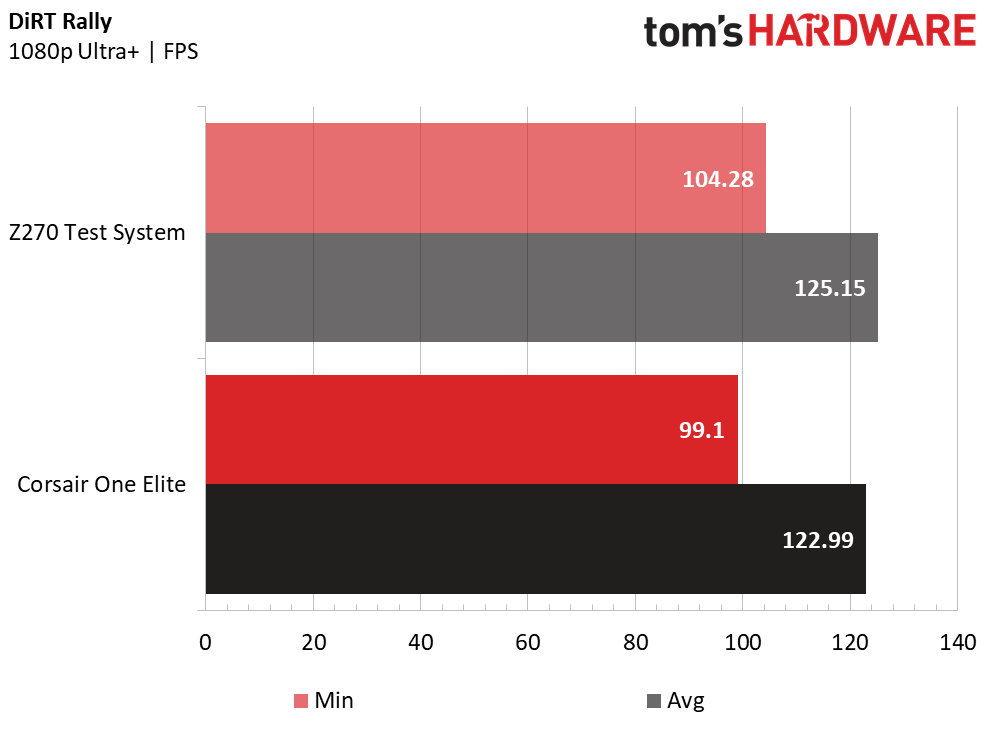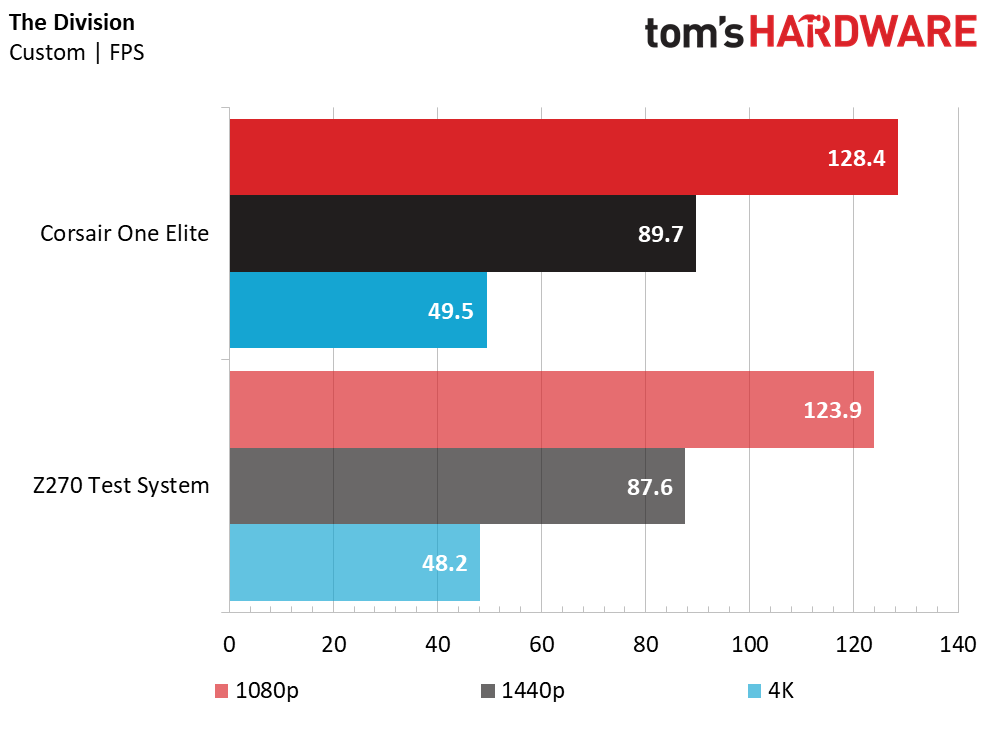Corsair One Desktop PC Review: Cooler than the Rest
Why you can trust Tom's Hardware
Gaming Benchmarks
Ashes of the Singularity: Escalation
The Corsair One Elite starts our gaming benchmark suite ahead of our Z270 test rig, with the CPU-intensive Ashes of the Singularity: Escalation tests posting higher framerates against our reference machine as you turn the resolution up. At 1920 x 1080, the One is ahead by an average of 3.4 FPS, but that margin grows as the pixel count rises. At 2560 x 1440, the difference is increased to 3.8 FPS, but at 4K we see the Core i7-8700K-equipped Corsair One Elite average 8.6 FPS higher than our previous-gen test rig. Clearly, CPU thread count matters in this particular game.
Bioshock Infinite



Bioshock Infinite is less complimentary to the newer platform, and the Corsair One Elite falls behind our test rig by a tiny margin at all tested resolutions. The older game sees more performance gains from CPU clock rate than core count, and the slightly lower Turbo frequency binning of the -8700K (4.3GHz with all cores engaged) could be the determining factor here (the 7700K reaches turbo frequencies of 4.4GHz with four cores active), but users won’t be able to see the difference in performance with the human eye.
DiRT Rally



We see much of the same phenomenon in the DiRT Rally benchmarks, where the Corsair One Elite falls ever-so-slightly behind our previous-gen test rig. At 1920 x 1080, the difference is more pronounced, with a 2.16 FPS (average) gap between the One and the Z270 platform. However, that margin is reduced to less than 1 FPS at 2560 x 1440 and 3840 x 2160. Similar to Bioshock, DiRT sees gains from clock speeds more than core count with all the settings maxed out, but the gap in performance is negligible, and both GTX 1080 Ti-equipped PCs provide excellent framerates with all the eye candy turned up.
Grand Theft Auto V



The Corsair One Elite resumes its dominance in the GTAV benchmarks, netting slightly higher average framerates than our Z270 test bench. The Core i7-8700K and GeForce GTX 1080 Ti have no problems delivering excellent framerates with the highest settings enabled at 1920 x 1080 and 2560 x 1440, and it even produces playable framerates at 4K.
Hitman



We retested our Z270 test bench, as several updates to the game and drivers (and possibly due to Spectre and Meltdown patches) seemed to cap performance of a GTX 1080 Ti around 99 FPS at 1920 x 1080 and 2560 x 1440. Even our previous 4K results were slightly behind, but the Corsair One expectedly beats our reference machine.
Rise of the Tomb Raider
The Corsair One Elite continues its slight lead in the Rise of the Tomb Raider benchmarks, coming in just ahead of our test rig by less than 1 FPS at all tested resolutions. The GPU clock speeds are the equalizers at these particular settings, and with both machines in the field matched, so too are the results.
The Division
We see much of the same results in The Division, where the Corsair One Elite outperforms our reference rig across the board. Enabling the highest settings at 4K pushes the One’s framerates down to a more-than-playable 49.5 FPS average, and you can assuredly hit 60 FPS by reducing the settings.
Get Tom's Hardware's best news and in-depth reviews, straight to your inbox.
Middle Earth: Shadows of War
The Corsair One Elite finishes our test suite strong, besting our Z270 reference machine in the Shadows of War benchmarks at 1920 x 1080. The Core i7-8700K is again responsible for the victory over the previous-gen counterpart, but the performance is equalized by the graphics card at 2560 x 1440 and 3840 x 2160. The One matches the other GTX 1080 Ti-equipped PC at those resolutions, averaging 55 FPS at 4K with all the highest detail settings enabled.
MORE: Best PC Builds
MORE: How To Build A PC
MORE: All PC Builds Content
Current page: Gaming Benchmarks
Prev Page Synthetic & Productivity Benchmarks Next Page Price Analysis & ConclusionDerek Forrest was a contributing freelance writer for Tom's Hardware. He covered hardware news and reviews, focusing on gaming desktops and laptops.
-
ledhead11 Thanks for the review. If I had the need or the money. . .Reply
Otherwise it's beautiful for an OEM and quite impressive. -
mlee 2500 Looks like a nice system, one I would consider but for one concern: How upgradable is the GPU? Are you locked into watercooled cards for the life of the machine (which usually extends through at least three generations of GPU's)?Reply -
zodiacfml This proves that intake fans are pointless unless you want to cool something directly, like an HDD or SSD that doesn't actually need much cooling.Reply -
photonboy ZODIACFML,Reply
Uh, first of all intake fans make sense for many PC's... also the Corsair One has an intake fan right on the top.
The air flow is to suck the air in the TOP and then it gets forced out the two radiators.
The Apple design is way better as it uses a core heatsink to mount stuff too and the intake fan is on the BOTTOM which forces air to flow up through the heatsink (that has CPU and 2xGPU mounted) and just goes out the top like a chimney.
Having TWO radiators with pumps seems a little wasteful for the Corsair One. I guess maybe that's what they are stuck with if they mostly use off-the-shelf parts.
I still don't understand why they didn't have the intake fan on the BOTTOM... probably the motherboard needed to be there for the connections to be more convenient and that would have gotten in the way of the fan.



